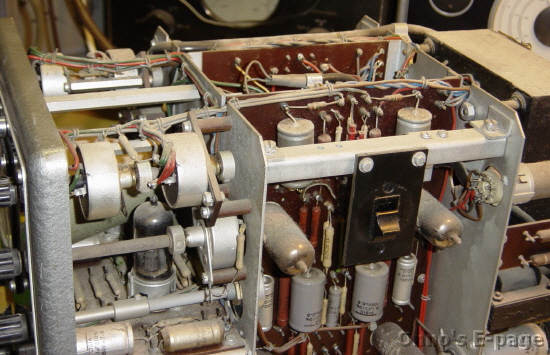Philips GM5659 oscilloscope (1953)


The GM5659 is an average laboratory oscilloscope that can display signals in the frequency range of 1 Hz to 1 MHz.
The CRT is a DG7-5, having a 7 cm screen. It has 12 other valves: 4 EF80's in the horizontal amplifier, 4 EF80's in the vertical amplifier, 2 ECC40's in the time base, and 2 AZ41 rectifiers. This is a predecessor of the more recent GM5659-01 scope, with minor differences such as the CRT and the type of circuit boards used. The circuit boards in this scope are made of phenolic board with soldering posts and hand wired interconnections. This is the same type of circuit board I found in the GM2883/03, which is about the same age.
I bought this scope in april 2006 on a flea market. The owner didn't know if it worked or not. But it looked good, and I thought I might be able to combine this one and the GM5659-01 I bought a month before to build a complete scope. Alas, this one, too, was missing the "funnel" in front of the CRT screen.
When I opened the scope, the inside looked as good as the outside. No rust, little dust. On the inside this scope was complete and did not have any damaged or missing components. The circuit boards did not have any traces of overheating and the valve sockets were clean. All the valves looked like new. No discolorations of the getter mirrors. So this scope has barely been used. Each and every of the soldering joints had a dot of black ink on them. This is a trick used by Philips to detect any repair attempts by others than the Philips workshops. So this scope had never been repaired before. Interestingly, some of the valves have a stamp stating they have been borrowed from the Philips Physics Laboratory. I don't know what to think of that.

Look at those circuit boards.
I tried the scope using a variac. I slowly turned up the mains voltage and saw that the voltages came up well. The scope did work, but the image was very distorted. I suspect that the linearity of the amplifiers is deteriorated because of leaky paper capacitors. But as this scope is still so much in original state, I don't think I want to replace up to 12 capacitors. I think I'll leave this nice old instrument as it is and fix the other one, the GM5659-01.
Copyright © 2006 by Onno's E-page published 2006-05-24, last updated 2006-11-29